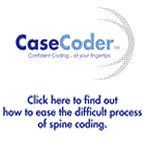| Email not displaying correctly? View it in your browser. | Issue #7 - March 6, 2013 |
|
Transitional Care Management: Worth the Effort New transitional care management (TCM) codes, introduced in CPT® 2013, allow providers to receive reimbursement for their efforts and the efforts of their staff to promote successful outcomes for patients transitioning from a facility setting (e.g., inpatient hospital, nursing facility) to a community setting (e.g., home, assisted living facility). 3 Tips Guide Successful Incident-to Billing Incident-to billing can be tricky. Services and supplies properly provided and billed incident-to a physician’s or non-physician practitioner’s services are reimbursed at 100 percent of the Medicare fee schedule amount for Medicare beneficiaries, providing an opportunity for practices to make the most of their auxiliary staff—but only if they adhere to the Center for Medicare & Medicaid Services’ (CMS) strict incident to requirements. The following quick tips help you cover the basics. Eye Exams vs. E/M Codes: Making the Proper Selection Both general ophthalmological services (92002-92014) and evaluation and management (E/M) codes (99201-99215) describe office visits for new or established patients. So, when should you apply the ophthalmological services codes rather than the E/M codes? |
|
|
Coding/Billing: Tips and Resources is offered as a benefit to AAPC members and we hope you find the information useful. If you'd rather not receive future issues, please login to your account and change your email preferences.
AAPC |
|
|
Copyright © 2013 AAPC - All rights reserved. CPT copyright 2012 American Medical Association. All rights reserved. Fee schedules, relative value units, conversion factors and/or related components are not assigned by the AMA, are not part of CPT, and the AMA is not recommending their use. The AMA does not directly or indirectly practice medicine or dispense medical services. The AMA assumes no liability for data contained or not contained herein. The responsibility for the content of any "National Correct Coding Policy" included in this product is with the Centers for Medicare and Medicaid Services and no endorsement by the AMA is intended or should be implied. The AMA disclaims responsibility for any consequences or liability attributable to or related to any use, nonuse or interpretation of information contained in this product. |


